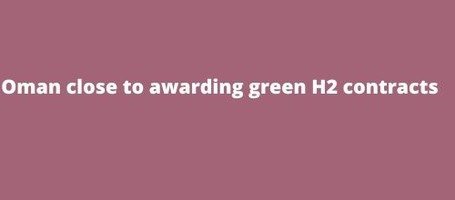Oman close to awarding green H2 contracts

Oman will award the first contract for a renewable hydrogen project on the back of a recently concluded auction “in the next few days”, and a second contract could be awarded next month, Salim Al Aufi said at the World Hydrogen Summit in Rotterdam.
The auction was launched by state-owned Hydrom late last year. The tender process for two 320m² plots of land in Duqm triggered “very fierce competition”, Al Aufi said.
The auction was initially scheduled to close in mid-February but the deadline was pushed back by a month. Around 50 companies had purchased the pre-qualification documents to participate in the first auction round, Firas Ali al-Abduwani said in January.
A second round of auctions will be launched “immediately” after the contracts for the first round have been awarded, Al Aufi said. Hydrom already signed binding terms for six agreements on renewable hydrogen projects in March plans for which were developed before the auction process was launched. These could provide a combined 750,000 t/yr, according to Al Aufi.
Oman has ambitious renewable hydrogen production targets (see table). The country is aiming for around 1mn t/yr by 2030 and 8mn t/yr by 2050. This would require electrolyser capacity of around 10GW and 100GW, respectively, Al Aufi said.
While the 2050 target is 8mn t/yr, Oman will have the potential to produce up to 25mn t/yr by then “if all goes well”, Al Aufi said. Only around 30pc of the available land would be needed to reach the 8mn t/yr goal, he added. There could be even more potential if additional renewable power generation capacity is installed offshore or if land that is currently reserved for the military is also utilised, according to the minister.
Much of the domestic renewable hydrogen production will be exported, although Oman may also be able to attract more industry to the sultanate thanks to its affordable energy and feedstock supply, Al Aufi said.
Three ports in the south of the country will be the initial focus for potential export hubs – the existing ports at Duqm and Salalah and a new port planned at Al Jazir. Hydrogen pipeline infrastructure will initially emerge around these ports, but by 2040 the northern cities Sohar and Sur could be connected to the pipeline network, while the capital Muscat could be linked by 2050, Al Aufi said.
Al Aufi highlighted the scale of the planned build-out and the resources needed for it. Reaching the 2050 target would require an investment of around $150bn. It would need 300mn solar panels, 44mn t of concrete, 25mn t of steel, 5.1mn t of glass, as well as vast amounts of copper, aluminium, silicon, nickel and plastic, he said.
While the focus will be on renewable hydrogen, Oman is also planning a pilot project to produce hydrogen from natural gas with carbon capture and storage (CCS). It is also investigating the possibilities of CO2 storage in the country, the minister said.
